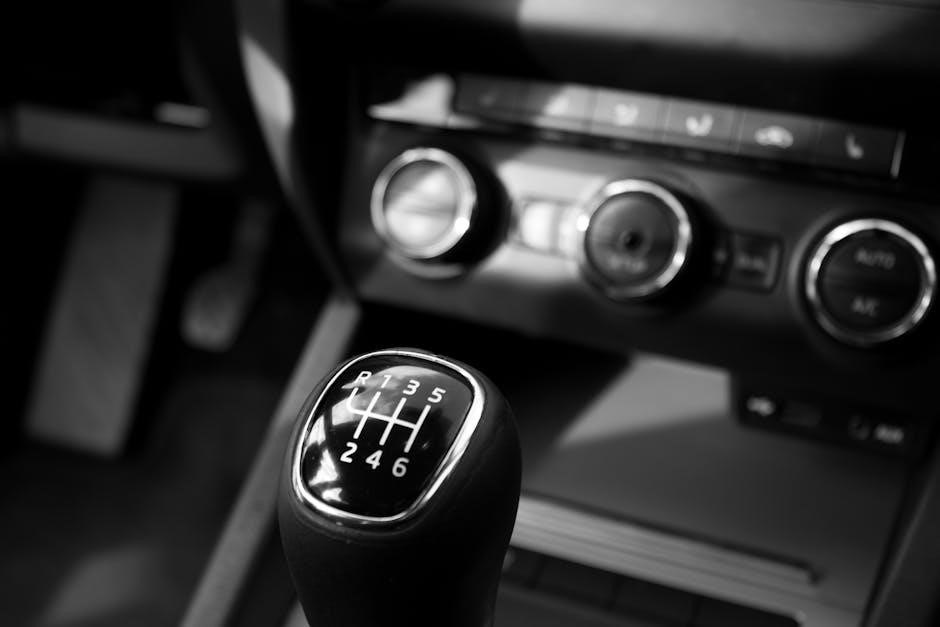Manual transmission driving classes provide structured learning, hands-on practice, and expert guidance to master the skills of driving a stick-shift vehicle with confidence and precision.
Benefits of Learning Manual Transmission
Learning to drive a manual transmission offers numerous advantages. It enhances control over the vehicle, improves fuel efficiency, and reduces wear on the engine and brakes. Manual driving also lowers maintenance costs compared to automatics. Additionally, it provides a more engaging and connected driving experience. Mastering manual transmission is a valuable skill, especially for those interested in driving vintage cars or navigating hilly terrains. It also broadens employment opportunities, such as driving jobs requiring manual skills. Overall, learning manual transmission is a rewarding investment that combines practicality with personal satisfaction.
Overview of Driving Classes for Manual Transmission

Driving classes for manual transmission are designed to equip learners with the necessary skills to operate a stick-shift vehicle confidently. These classes typically begin with theoretical instruction, covering the mechanics of manual transmission and the proper use of clutch and accelerator pedals. Instructors then guide students through practical exercises, starting in controlled environments like empty parking lots to practice gear shifting, clutch control, and smooth acceleration. As learners progress, they move to real-world scenarios, such as city driving and uphill navigation, to refine their techniques. The goal of these classes is to ensure students can handle various driving conditions with precision and ease, preparing them for both everyday commuting and more challenging situations.

Understanding the Basics of Manual Transmission
Manual transmission involves using a clutch pedal and gearshift to control speed and torque, enabling precise driver control over the vehicle’s movement and acceleration.
Components of a Manual Transmission System

A manual transmission system consists of several key components that work together to enable smooth and precise gear shifting. The clutch pedal allows the driver to disconnect the engine from the transmission, while the gearshift selects the desired gear; The transmission unit houses the gears and synchronizers, which facilitate seamless transitions between gears. The flywheel is connected to the engine and works with the pressure plate to engage or disengage the clutch. Additionally, bearings and seals ensure smooth operation and prevent leakage. Understanding these components is essential for mastering manual transmission driving, as they directly impact the vehicle’s performance and control.
The Role of the Clutch and Accelerator
The clutch and accelerator are essential components in manual transmission driving, requiring precise coordination to ensure smooth gear shifts. The clutch pedal disconnects the engine from the transmission, allowing the driver to shift gears without grinding. The accelerator pedal controls engine speed, which must be synchronized with clutch operation for seamless transitions. Proper use of these pedals involves pressing the clutch fully, shifting gears, and slowly releasing the clutch while gently pressing the accelerator. This coordination prevents jerky movements and wear on the transmission. Mastery of the clutch and accelerator is foundational for controlling the vehicle effectively, especially when starting from a standstill, climbing hills, or navigating varying road conditions.
Practicing Manual Transmission Techniques
Mastering manual transmission involves consistent practice in a controlled environment, focusing on smooth gear shifts, clutch control, and coordination with the accelerator to ensure seamless vehicle operation.
Mastering Gear Shifting
Mastering gear shifting is a critical skill in manual transmission driving, requiring coordination between the clutch pedal, accelerator, and gear lever. Proper technique involves smooth, deliberate movements to match the vehicle’s speed with the appropriate gear. Instructors emphasize the importance of listening to engine RPMs to determine when to shift, ensuring efficient acceleration and preventing wear on the transmission. Practice in a controlled environment, such as an empty parking lot, allows learners to focus on shifting without the pressure of traffic. Over time, consistent practice helps drivers develop muscle memory, enabling seamless transitions between gears and enhancing overall driving performance.
Smooth Clutch and Accelerator Coordination
Smooth clutch and accelerator coordination is essential for effective manual transmission driving. This technique involves gradually releasing the clutch pedal while simultaneously pressing the accelerator to avoid jerky starts or stalling. Proper coordination ensures a seamless transition of power from the engine to the wheels, improving control and reducing wear on the transmission. During lessons, instructors often emphasize the importance of slow, deliberate movements to synchronize these actions effectively. Practice in low-traffic areas allows learners to focus on mastering this skill without the stress of real-world driving conditions. Over time, consistent practice builds muscle memory, enabling drivers to shift gears and accelerate smoothly, even in complex situations like uphill starts or merging into traffic.
Finding the Right Instructor for Manual Transmission
Finding a qualified instructor is crucial for mastering manual transmission. Look for someone with extensive experience in teaching stick-shift driving, who offers personalized lessons, clear feedback, and a patient approach to help you build confidence and skill behind the wheel.

Qualities of an Effective Driving Instructor
An effective driving instructor for manual transmission should possess patience, strong communication skills, and the ability to break down complex techniques into simple, understandable steps. They should have extensive experience in teaching stick-shift driving, allowing them to anticipate common challenges and tailor lessons to individual needs. A good instructor fosters a calm and encouraging learning environment, helping students build confidence behind the wheel. They should also provide clear, constructive feedback and emphasize safe driving practices. Additionally, an effective instructor stays up-to-date with the latest teaching methods and adapts their approach to suit different learning styles. Their goal is to ensure students not only master manual transmission but also develop a lifelong foundation of safe and skilled driving habits.
Choosing the Right Driving School
When selecting a driving school for manual transmission classes, it’s essential to evaluate their expertise, reputation, and teaching methods. Look for schools with experienced instructors who specialize in stick-shift training and have a proven track record of success. Research their curriculum to ensure it covers both theoretical and practical aspects of manual driving. Read reviews and ask for referrals to gauge student satisfaction and outcomes. Additionally, consider the school’s approach to hands-on practice, ensuring they provide ample opportunity to master gear shifting and clutch control. A well-structured program with clear progression and feedback mechanisms will help you learn efficiently. Finally, verify the school’s certifications and credentials to ensure you’re receiving high-quality instruction tailored to your needs.
Overcoming Challenges in Manual Transmission Driving
Mastering manual transmission requires patience and practice. Common challenges include stalling, smooth acceleration, and clutch coordination. Consistent practice in a safe environment helps build confidence and control.
Common Mistakes to Avoid
When learning manual transmission, common mistakes include riding the clutch, which can wear it down, and shifting gears without fully pressing the clutch. These errors can lead to stalling or damage. Another mistake is not using the correct gear for speed, causing the engine to strain or over-rev. Additionally, failing to coordinate the clutch and accelerator smoothly can result in jerky starts. Instructors emphasize proper techniques to avoid these issues, ensuring safer and more efficient driving. By understanding these pitfalls, learners can focus on improving their skills and developing good habits behind the wheel. Consistent practice helps eliminate these mistakes over time.

Building Confidence in Manual Driving
Building confidence in manual driving requires consistent practice and a positive learning environment. Instructors often start lessons in controlled settings, such as empty parking lots, to help learners feel comfortable with basic operations. Gradually introducing more challenging scenarios, like inclines or traffic, helps build skill and assurance. Personalized feedback is crucial, as it addresses specific areas for improvement. Celebrating small victories, such as smooth gear shifts or confident starts, reinforces progress. Over time, learners develop muscle memory and the ability to anticipate road conditions, leading to greater confidence. Patience and persistence are key, as mastering manual transmission is a process that rewards dedication and practice.

Additional Resources for Manual Transmission Learners
Supplementary guides, online tutorials, and forums provide valuable support for mastering manual driving. Tools like the Search Strategy Builder and library databases offer advanced techniques for refining skills and troubleshooting common challenges.
Supplementary Materials and Guides
Supplementary materials and guides play a crucial role in enhancing the learning experience for manual transmission driving. These resources include detailed manuals, video tutorials, and interactive simulations that provide step-by-step instructions on mastering gear shifting, clutch control, and acceleration coordination. Many driving schools offer comprehensive guidebooks that cover the theoretical aspects of manual driving, such as understanding the mechanical components of the transmission system and the principles of smooth driving. Additionally, online platforms provide accessible tools like the Search Strategy Builder, which helps learners refine their search queries to find relevant information quickly. These materials are designed to complement practical lessons, allowing learners to reinforce their skills and address specific challenges they encounter during training.
Online Communities and Forums
Online communities and forums offer valuable support for learners mastering manual transmission driving. These platforms provide a space to share experiences, ask questions, and receive advice from experienced drivers and instructors. Many forums discuss common challenges, such as mastering the clutch and gear coordination, and offer tips for overcoming them. Some communities also share supplementary materials, like detailed guides and video tutorials, to aid in the learning process. Additionally, these forums often include discussions on the best driving schools and instructors, helping learners make informed decisions. By engaging with these online resources, learners can build confidence, gain practical insights, and stay motivated throughout their journey to becoming proficient in manual driving.

